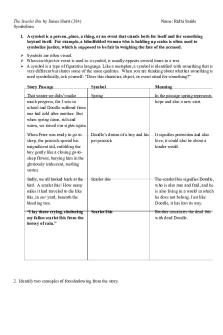LIT-100 Symbolism Essay PDF

| Title | LIT-100 Symbolism Essay |
|---|---|
| Author | Rachael Martin |
| Course | Introduction to Literature |
| Institution | Southern New Hampshire University |
| Pages | 3 |
| File Size | 62.9 KB |
| File Type | |
| Total Downloads | 64 |
| Total Views | 142 |
Summary
Essay about "The Birth-Mark" by Nathaniel Hawthorn and "The Thing in the Forest" by A.S. Byatt...
Description
Martin 1 Rachael Martin Margo Bond-Collins LIT-100 25 Sept. 2015 Symbolism Symbolism is an important element in the two short stories "The Birth-Mark" by Nathaniel Hawthorn and "The Thing in the Forest" by A.S. Byatt as it helps to convey the overall themes of the stories. Each story has one main symbol that represents the larger idea of the work. Hawthorne's story was about a husband and wife named Aylmer and Georgiana. On the cheek of Georgiana, there was a red, hand-shaped birthmark. Her husband, who was a scientist, became disgusted with the mark and decided to remove it. Unfortunately, the removal of the mark caused Georgiana's death. The birthmark, the major symbol in the story, represented human imperfection and morality. This became obvious when the birthmark was called both a "mark of earthly imperfection" (291) and a "symbol of his wife's…decay, and death" (292). Georgiana herself even called it a "birth-mark of morality" (300). The overall theme of the story was that no human is capable of being perfect, because every person is mortal and will die. When the mark was removed, Georgiana quickly died because "the fatal hand…was the bond by which an angelic spirit kept itself in unison with a mortal frame" (301). The mark had been hand-shaped because it held life, and with it gone, there was only death. Byatt's story was about two young girls, named Penny and Primrose, who were evacuated to the English countryside during World War II. While staying at a house, they go into a forest together where they see a strange, monstrous creature. After the encounter with the "Thing", the story goes on to tell what happened to the girls as they grew up and eventually, by coincidence,
Martin 2 met each other again in the house where they had stayed together. The Thing symbolized childhood fear and the loss of innocence. The girls were anxious and afraid due to being shipped from home for a reason they did not understand to a place they had never been. These worries manifested themselves into the Thing while they were in the forest. Before entering the forest, a little girl named Alys was mentioned. Her young age and appearance was that of quintessential childhood innocence. Alys wanted to come with the girls into the forest, but they ran, leaving her behind (305-306). Alys symbolized innocence, while the Thing symbolized the fear of the unknown and the loss of innocence. By seeing the Thing, they left behind their innocence and found fear. In other words, their childhood ended. Even though fear is not a physical being, the two girls saw it as "a real thing in a real place" (308) and that "something that resembled unreality had lumbered into reality" (314). The symbols in this story help the readers to see the overall theme of the story, which is that fear is real and forces children to grow up. Fear psychologically affects those who experience it for the rest of their lives. In conclusion, "The Birth-Mark" by Nathaniel Hawthorn and "The Thing in the Forest" by A.S. Byatt both rely heavily on symbolism as an element to convey the deeper meanings and themes of the writings. In Hawthorne's story the birthmark represented human morality and imperfection, while the monster in Byatt's story represented the end of childhood. For a reader, it is important to learn how to understand and interpret symbols to see the themes and make the overall reading experience more enjoyable.
Martin 3 Works Cited Mays, Kelly J. The Norton Introduction to Literature. 11th ed. New York City: W.W. Norton & Company, Inc., 2013. Print....
Similar Free PDFs

Eveline Symbolism Essay
- 2 Pages

Macbeth Symbolism essay
- 5 Pages

The Piano Symbolism essay
- 2 Pages

LIT-100 Symbolism Essay
- 3 Pages

TAROT SYMBOLISM & DIVINATION
- 118 Pages

Islamic Symbolism
- 10 Pages

Trifles Symbolism
- 5 Pages

The Tortilla Curtain Symbolism
- 6 Pages

Name symbolism in Dorian Gray
- 3 Pages

Mysticism and Symbolism
- 46 Pages

Symbolism in The Namesake
- 1 Pages

Hedda Gabler Symbolism
- 1 Pages

Creative Assignment on Symbolism
- 1 Pages
Popular Institutions
- Tinajero National High School - Annex
- Politeknik Caltex Riau
- Yokohama City University
- SGT University
- University of Al-Qadisiyah
- Divine Word College of Vigan
- Techniek College Rotterdam
- Universidade de Santiago
- Universiti Teknologi MARA Cawangan Johor Kampus Pasir Gudang
- Poltekkes Kemenkes Yogyakarta
- Baguio City National High School
- Colegio san marcos
- preparatoria uno
- Centro de Bachillerato Tecnológico Industrial y de Servicios No. 107
- Dalian Maritime University
- Quang Trung Secondary School
- Colegio Tecnológico en Informática
- Corporación Regional de Educación Superior
- Grupo CEDVA
- Dar Al Uloom University
- Centro de Estudios Preuniversitarios de la Universidad Nacional de Ingeniería
- 上智大学
- Aakash International School, Nuna Majara
- San Felipe Neri Catholic School
- Kang Chiao International School - New Taipei City
- Misamis Occidental National High School
- Institución Educativa Escuela Normal Juan Ladrilleros
- Kolehiyo ng Pantukan
- Batanes State College
- Instituto Continental
- Sekolah Menengah Kejuruan Kesehatan Kaltara (Tarakan)
- Colegio de La Inmaculada Concepcion - Cebu


